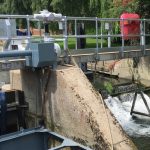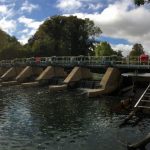Modular weir gate design slashes time to complete refurbishment project at Cookham Weir
Cookham lock has seen renovation work carried out in 1869, 1957 and more recently in 2016 thanks to the support of ECS Engineering Services. The Nottinghamshire based fabrication and water control experts were contacted by Jackson Civil Engineers, working for the Environment Agency to replace 10 weir gates and install two fish passes at Cookham Weir, ensuring the continued reliable control of water levels at the tourist hotspot for years to come.
Cookham Lock denotes where the River Thames meets Chiltern chalk at Cliveden Cliff, where the surrounding woods and picturesque landscape attract anglers, walkers, river travellers and bird watchers from across the country. Due to the sensitivity of the area, ECS Engineering Services was first choice due to its focus on completing projects quickly and in an environmentally sensitive manner, minimising disruption on-site.
The 10 new weir gates form part of a larger project replacing ageing assets as part of the Environment Agency’s continued investment in water control facilities along this stretch of the River Thames.
ECS designed, manufactured and installed all the equipment for this project including a significant drives and controls upgrade. ECS carried out the work in-house at their dedicated fabrications centre, allowing the gates to be delivered in ready assembled, slashing installation times on-site.
Installation of the gates required a section of the weir complex to be drained before work could begin. Once the weir gate sections had been isolated, ECS was able to install the new gates with minimal fuss due to the exact fit of the gates within the existing structure. This minimised disturbance on the watercourse and to the surrounding environment, a key proviso for the Environment Agency.
The highly oxygenated water at Cookham Lock also makes it a hotspot for fish, with everything from pike to barbel utilising this stretch of river. To improve safe fish migration, ECS designed and installed two Larinier fish pass channels in redundant gate bays to allow the movement of fish up and downstream. Fish are channelled into a ‘ladder’ which incorporates ‘rungs’ that the fish can move through, with each rung offering fish a chance to rest before tackling the next section. The whole project ensured minimal disruption to the environment whilst improving the natural fish population.
Jamie Wesley, Contracts Manager at ECS expanded: “Our expertise and experience working with the Environment Agency means we take on these projects with the utmost confidence. Our comprehensive fabrications workshop ensures we not only protect the environment during the project, but also provide a reliable cutting edge solution for the end user.”
- ECS Engineering Services designed, manufactured and installed all the equipment for this project including a significant drives and controls upgrade.
- The 10 new weir gates form part of a larger project replacing ageing assets as part of the Environment Agency’s continued investment in water control facilities along this stretch of the River Thames.







